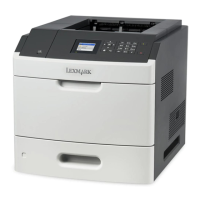Deviations
165
F
Deviations
This section describes deviations in the Forms and Bar Code Card that are either different than the
HP BarDIMM Pro version 3.3A1 (referred to as “HP BDP”), or the Lexmark Bar Code Card version
3.3. (referred to as “LXK BCC”).
Note: The bar code engine is referred to as “BCE” in this section.
Code 93 uppercase vs. lowercase
The Code 93 bar code uses the same encoding as Code 39.
The HP BDP converts lowercase “a–z” character input to uppercase, and the bar code scan contains
only uppercase. However, the HRT is printed as lowercase, reflecting the input data, rather than the
actual bar code encoded data, which this Technical Reference considers as an error.
The LXK BCC also performs the exact same way as the HP BDP.
The BCE does not support lowercase “a–z” character input, and does not translate to uppercase,
and is operating per the specifications in the URLs noted above.
Therefore, the Forms and Bar Code Card firmware must convert any code 93 lowercase input to
uppercase before submission to the BCE. This will generate the proper uppercase characters within
the bar code. However, visually the HRT will also be uppercase, reflecting the actual data within the
bar code itself.
Codabar uppercase vs. lowercase
The Codabar bar code uses two different bar and space widths: narrow, and double-wide.
This symbology also uses a single narrow inter-character space to separate each character. Each
character contains exactly four bars, and three spaces. Due to this encoding, each bar code
character width may vary slightly depending on the character being encoded. A single start character
(A, B, C, or D) and stop character (A, B, C, or D) brackets the numeric data encoded within the bar
code.
The HP BDP converts lowercase “a, b, c, d” start and stop character input to uppercase “A, B, C, D”,
and the bar code image itself is encoded properly with uppercase characters for the start and stop
characters. However, the HRT start and stop characters are printed as lowercase, reflecting the
input data, rather than the actual bar code encoded data, which this Technical Reference considers
as an error.

